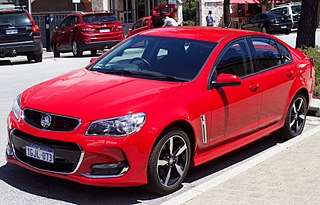Related Research Articles

Holden, formerly known as General Motors-Holden, was an Australian subsidiary company of General Motors. It was an Australian automobile manufacturer, importer, and exporter that sold cars under its own marque in Australia. In its last three years, it switched entirely to importing cars. It was headquartered in Port Melbourne, with major industrial operations in the states of South Australia and Victoria. The 164-year-old company ceased trading at the end of 2020.

The Holden Commodore is a full-size car that was sold by Holden from 1978 to 2020. It was manufactured from 1978 to 2017 in Australia and from 1979 to 1990 in New Zealand, with production of the locally manufactured versions in Australia ending on 20 October 2017.

The Holden Monaro is a rear-wheel drive coupé manufactured by General Motors Holden in Australia from 1968 to 1975 and later reintroduced from 2001 to 2006. It was also manufactured as a 4-door sedan from 1973 to 1977.

Holden Special Vehicles (HSV) was the officially designated performance vehicle division for Holden. Established in 1987 and based in Clayton, Victoria, the privately owned company modified Holden models such as the standard wheelbase Commodore, long wheelbase Caprice and Statesman, and commercial Ute for domestic and export sale. HSV also modified other non-Holden cars within the General Motors lineup in low volumes.

Zeta was the original name for General Motors' full-size rear-wheel drive automobile platform developed by GM's Australian subsidiary company Holden and was at one stage referred to as the "GM Global RWD Architecture". The GM Zeta platform replaced the V-body, and debuted with 2006 Holden Commodore (VE) sedan and Holden (VE) Ute. This platform was considered as the replacement for the North American W, H, and K platforms until plans were cancelled due to fuel-economy considerations and GM's financial situation. Although the future of the Zeta program was in doubt at that time, in May 2009, Holden began the development of an improved second version of the platform that went on to form the basis of the 2013 Commodore (VF) and Chevrolet SS.

The Holden Commodore (VE) is an executive car that was produced by Holden from 2006 to 2013. It was the first iteration of the fourth generation of the Commodore. Its range included the luxury variants, Holden Berlina (VE) and Holden Calais (VE); utility models were included as the Holden Ute (VE).

The Holden Commodore (VY) is an executive car that was produced by Holden from 2002 to 2004. It was the third iteration of the third generation of the Commodore. Its range included the luxury variants, Holden Berlina (VY) and Holden Calais (VY); commercial versions were called the Holden One Tonner (VY), Holden Ute (VY), and Holden Crewman (VY). In 2003, the range also saw the introduction of the first Commodore-based all-wheel drive variants, including the Holden Adventra (VY) wagon.
Toyota Australia is an Australian subsidiary of the Japanese car manufacturer Toyota. It markets Toyota products and manages motorsport, advertising and business operations for Toyota in Australia. It is also responsible for Lexus vehicles in Australia.

A ute, originally an abbreviation for "utility" or "coupé utility", is a term used in Australia and New Zealand to describe vehicles with a tonneau behind the passenger compartment, that can be driven with a regular driver's licence.

The Holden was a full-sized car produced by the company of the same name across 5 generations from 1948 until 1984. The Holden is also commonly referred to by their model designation and also the H Series. The Holden was introduced to be Australia's car, being the first full scale produced automobile exclusive to the country. Prior to which, General Motors Holden's Ltd. assembled imported CKD kits from overseas General Motors subsidiaries such as Chevrolet, Buick, Vauxhall and more. And the only other cars built in the country being Ford and Chrysler vehicle bodies fitted to imported chassis. The Holden was an instant success among Australians, being the first production car built solely for Australia's unique, rough roads.
General Motors New Zealand Limited, is a subsidiary of General Motors that distributes GM' motor vehicles, engines, components and parts in New Zealand.

The Holden Commodore (VR) is an executive car which was produced by Holden from 1993 to 1995. It was the third iteration of the second generation of the Holden Commodore. The VR range included the luxury variants, Holden Commodore Berlina (VR) and Holden Calais (VR) and a commercial model, the Holden Ute (VR).

The Holden Commodore (VS) is an executive car which was produced by Holden from 1995 to 1997 and 2000 for utility versions. It was the fourth and final iteration of the second generation of the Commodore. The range included the luxury variants, Holden Berlina (VS) and Holden Calais (VS).

The Holden Commodore (VX) is an executive car that was produced by Holden from 2000 to 2002. It was the second iteration of the third generation of the Commodore. Its range included the luxury variants, Holden Berlina (VX) and Holden Calais (VX), and it formed the basis for a new generation Holden Ute (VU) coupé utility and Holden Monaro (V2) coupé.
The Holden Special Vehicles GTS is a performance vehicle produced by Australian company Holden Special Vehicles (HSV), the performance division of Holden. The GTS was introduced in 1992 along with the VP Series ClubSport as a flagship model for the HSV brand, featuring more luxury fittings, along with higher output engines and stronger running gear. From 1994 until 1997, the GTS featured a 5.7L stroker version of the 5000i Holden V8, before being replaced by the Chevrolet Gen III small block V8. In 1998 the HSV GTSR was released, as a limited production run featuring a worked engine, custom interior and unique XU3 Yellah paintwork. These cars have since sold for upwards of $1,000,000 (AUD), in 2017, HSV announced the HSV GTSR W1, 275 examples were slated for production in 2018, after the closure of Holden's Elizabeth plant, its last Australian manufacturing plant. The W1 featured a 6.2 Liter, Supercharged 'LS9' V8 out of a C6 Corvette ZR1, Custom made carbon fibre parts, fully custom interior, and much more. Additionally, 4 examples of the HSV GTSR W1 Maloos were produced, initially not supposed to be produced, however, four tempting Maloo ute bodies sitting aside got to a few workers who then pitched it to management, they allowed it since the whole point of the W1 was for the company to go out in style, these cars are now four of the most valuable road cars ever produced in Australia, being as rare as a complete Ford Falcon XA GTHO Phase IV, which also ended production after 4 vehicles.

A substantial car industry was created in Australia in the 20th century through the opening of Australian plants by international manufacturers. The first major carmaker was Ford Australia and the first Australian-designed mass production car was manufactured by Holden in 1948. Australian manufacture of cars rose to a maximum of almost half a million in the 1970s and still exceeded 400,000 in 2004. Australia was best known for the design and production of 'large' sized passenger vehicles. By 2009 total production had fallen to around 175,000 and the Australian market was dominated by cars imported from Asia and Europe.

The Holden Commodore (VF) is an executive car that was produced by Holden between June 2013 and October 2017. It was the second and last significantly restyled iteration of the fourth (and final) generation of the Holden Commodore to be manufactured in Australia. Its range included the sedan and station wagon variants that sold under the luxury Holden Calais (VF) nameplate. Also available was the commercial utility variant that sold under the Holden Ute (VF) nameplate.
Corsa Specialised Vehicles (CSV) is a small-scale automaker established in 1994 that is based in Mildura, Victoria, Australia. Its range consists of V8-engined high performance cars based on those produced by Holden.
The Holden Woodville Plant was a manufacturing facility owned by the Australian motor vehicle manufacturer Holden situated in Cheltenham, South Australia, a suburb of Adelaide.

The Holden Special Vehicles Maloo, is a performance coupé utility, or ute, built by Holden's performance vehicles department, Holden Special Vehicles (HSV), in Clayton, Victoria, produced from 1992 until 2017, the Maloo holds a world record for worlds fastest truck/ute, the car, a LS2 powered VY series Maloo R8 achieved a top speed of 271.44 km/h (168.66 mph) in 2006, Beating the record previously held by the Dodge Ram SRT-10 by over 20 km/h. However Succeeding Maloos have surpassed this figure. The Maloo is to put it simply, a Ute version of HSV's ClubSport sedan. The Maloo was produced across three main variants: Maloo R8, Maloo R8 SV and Maloo GTS, however many others were produced throughout its lifetime, including the Gen F2's Maloo GTSR, and four examples of the 474kW LS9-powered Maloo GTSR W1, after HSV staff discovered they had 4 excess Maloo GTSR bodies at their disposal, the Maloo GTSR W1 was never intended for production, however HSV let it slide and went ahead with the 4 examples, one in Light My Fire, the car most known Maloo W1, with the iconic Victorian 'W1UTE' HSV signature plates, one in XU-3 Yellah, the same colour as the original VR GTSR, one in Red, Holden's Hero colour and finally, Matte Grey. These are now valued at well over $1 Million (AUD).
References
- ↑ "Billion dollar baby". smh.com.au. 2006-07-19. Retrieved 2022-11-10.
- ↑ "PM - Holden rolls out 'Billion Dollar Baby". abc.net.au. 2006-07-17. Retrieved 2022-11-10.
- ↑ "W1 - Australian Superpower". hsv.com.au. Retrieved 2022-11-10.
- ↑ "last holden built in australia". voanews.com. 2017-10-20. Retrieved 2022-11-10.
